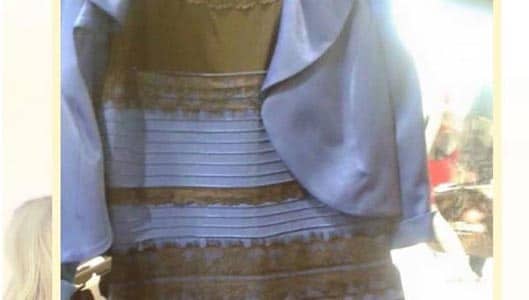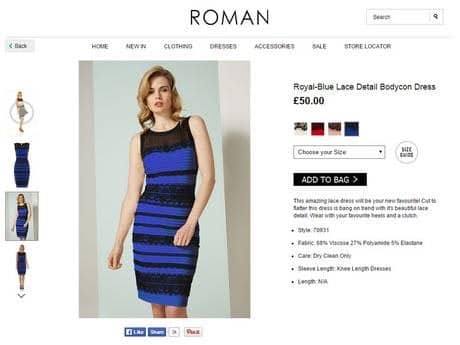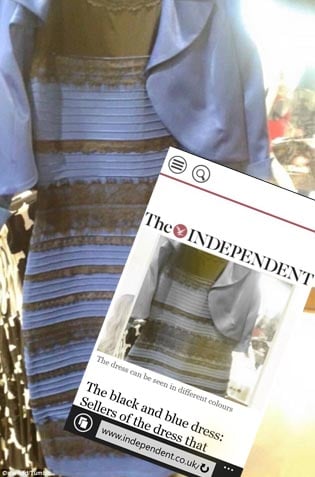3 Reasons why people see “the dress” in different colours.
If you’ve been hearing some nonsense about the colour of a dress recently, then you’re certainly not alone.
Social media has blown up over people disagreeing about the colour of a dress in a photo. But what’s it all about? A joke, or a genuine difference of opinion?
It’s the latter. People really are seeing different colours when they see the dress in the photo, in what is turning out to be a pretty weird optical illusion. And it all started when it was uploaded to tumblr by Caitlin McNeill after she and a friend couldn’t agree on its colour.
Well, sorry for those in the white and gold camp. You’re wrong. The dress has been tracked down by media and they’ve even interviewed the designer. The dress is very much blue and black. End of.
Period.
Personal expectations, the inner workings of our eyes and brain, as well as the quality of the display used to view the image have all been attributed to the strangest online debate we’ve had in a while. And like all good debunkers, we’d be amiss not to conduct our own little experiment here in the ThatsNonsense.com offices.
We showed half of our subjects the dress on a top quality HD desktop monitor first and then on an inferior mobile display on a Nokia phone. The other half saw it on the mobile first and then the desktop monitor. As you can see, we think display is the most important factor at work here.
Everyone who saw the dress on a desktop monitor first correctly identified the colour, and stuck to their guns about the colour when seeing the photo on a mobile platform afterwards.
Out of the people who saw the dress on a mobile first, half opted correctly and half opted for white and gold. A split straight down the middle!
However… after then seeing it on the desktop computer, those who saw white & gold began to correct themselves. Not everyone though – some still saw it as white and gold! As expected, those who saw blue and black on the mobile first still saw that on the desktop monitor second.
This confirmed our suspicions that the display on which the dress is viewed perhaps plays the most important part when deciphering the colour, since more people correctly identified the colour when seeing it on a desktop monitor, regardless of whether they viewed it on a desktop first or second.
So what does our experiment tell us? It backs the theory that all 3 factors actually play a part in the confusion.
An existing expectation seems to play a small role since a handful of subjects who saw the mobile version first and got the colours wrong still maintained they could see the incorrect colours on the superior desktop display. However no one who saw the desktop first (who all got the colours correct) went on to change their minds when they saw the dress on the inferior mobile display.
Secondly, everyone’s eyes and brains interpret colours slightly differently, since colours are merely different wavelengths that get interpreted by our brains and everyone’s brain works slightly differently to anyone else, and this also plays a role (as Wired.com explains.), which is why out of the people we showed the image of the dress on the mobile first, half went one way and the other half went the other way, despite seeing the same image on the same display in the same conditions. It would seem that on this inferior display, the image seems to be on some kind of perception-cusp, where you would be just as likely to go one way or the other when interpreting colour.
However for us, the quality of the display seemed to be the most important factor. Everyone who saw the desktop monitor first got the colours right, and most people who saw the desktop monitor second also saw the correct colours, even if they originally though it was white and gold on the mobile. Okay, our experiment was quite small, but even we could see, when pulling the same image up on both displays at the same time, that the dress photo on the mobile display was much less clear – you can see the difference in the photo below, where the blue is less saturated in the mobile version (inset) and thus more likely to be interpreted as a grey or white, and the gold tint is stronger.
Anyway, the whole thing has been great for the designer. The dress has now sold out. And before you ask, yes, they are considering a white and gold version.
Remember – to keep up-to-date with Internet nonsense out there, like our Facebook page and Twitter feed.
Continued below...
Thanks for reading, we hope this article helped, but before you leave us for greener pastures, please help us out.
We're hoping to be totally ad-free by 2025 - after all, no one likes online adverts, and all they do is get in the way and slow everything down. But of course we still have fees and costs to pay, so please, please consider becoming a Facebook supporter! It costs only 0.99p (~$1.30) a month (you can stop at any time) and ensures we can still keep posting Cybersecurity themed content to help keep our communities safe and scam-free. You can subscribe here
Remember, we're active on social media - so follow us on Facebook, Bluesky, Instagram and X


